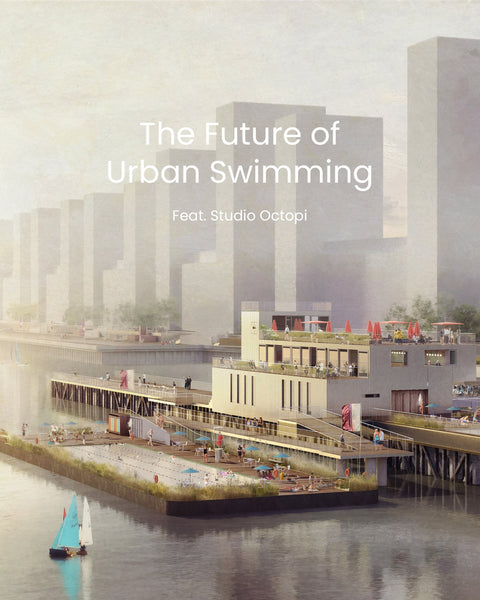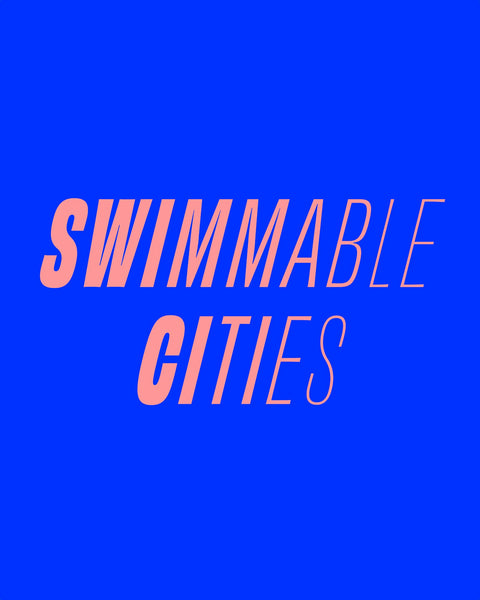
In 2027 Copenhagen is poised to celebrate a quarter-century since the inauguration of its first harbour bath. This upcoming landmark anniversary underscores a growing international movement toward embracing harbour baths, tidal pools, and outdoor public swimming facilities in urban landscapes.
At the forefront of this architectural revolution is Studio Octopi, a London-based firm whose commitment to integrating aquatic leisure spaces into city life is unmatched. In this feature, Chris Romer-Lee, co-founder, and visionary architect behind Studio Octopi, takes us through the evolution and latest advancements in this transformative journey, aiming to immerse more urban residents in the refreshing embrace of water.
Eleven years have passed since Studio Octopi's inaugural concept for Thames Baths was unveiled through a captivating CGI representation in the London Evening Standard, sparking an unexpected surge of interest from both Londoners and international observers. This innovative design featured a floating lower pool that adapted to the Thames' 6-meter tidal range, while the upper pool, positioned just beneath the high-water mark, was refreshed with brackish river water twice daily, offering bathers six hours of rejuvenating swims.

Thames Baths visualisation by Studio Octopi
Despite the ensuing eight years of navigating through scepticism from authorities and wavering commitment from developers, the physical realization of Thames Baths remains on the horizon. However, this journey ignited a deeper passion within me to envision and create community pools worldwide, democratizing access to the health benefits of seawater at a time when the need is more pressing than ever amidst a global swimming pool crisis and escalating city temperatures.
A Global Swimming Pool Crisis
Europe is currently facing a severe swimming pool crisis, exacerbated by rising construction costs and an acute energy shortage. This dire situation has led to significant operational changes across the continent: community pools in Germany are lowering their water temperatures to cut costs, France is witnessing pool closures, and in the UK, Swim England has reported the closure of 1,000 pools since 2010, with an additional 1,500 facilities nearing the end of their useful life after four decades of service. Alarmingly, this decline disproportionately affects the most underprivileged communities, where public pools are closing at three times the rate of those in wealthier areas.
Looking towards Australia, a staggering 40% of public swimming pools are projected to reach the end of their operational life by 2030, with replacement costs estimated at around AU$ 8 billion. However, there is a silver lining as Australia looks ahead. A 2020 study by the University of New South Wales' School of Civil and Environmental Engineering proposed a cost-effective solution: constructing ocean pools for AU$ 3-8 million each, with annual operating expenses of approximately AU$ 100,000. These ocean pools are expected to attract up to 150,000 visitors annually, generating health and economic benefits valued between AU$ 6-10 million per year — or about AU$ 40 per visit. Such compelling data highlights the potential for innovative solutions to mitigate the global swimming pool crisis.
The Dawn of Tidal Pools
Tidal pools, a seawater-fed pool that naturally overtops twice a day on the high tide, trace their origins back to the late 18th century in the UK. Among the pioneers, Lady Basset’s Baths, established in 1782 in Cornwall, stand out as quintessential examples. These pools, hewn directly from granite by the family's own stonemason, featured at varying elevations within the intertidal zone, ensuring a continual supply of fresh seawater. Sized comparably to large bathtubs, with some even boasting rock-carved steps for entry and exit, these pools have, over two centuries of exposure to the elements, acquired a smooth, almost organic texture, a stark contrast to the harsh lines of man-made construction.
The era also saw Dr. Richard Russell, a visionary physician, championing the health benefits of seawater, advocating for both its immersion and ingestion as remedies for a plethora of conditions. This belief catalysed a shift from the inland mineral spas, like those in Bath, to the untamed beauty of the coast, setting the stage for the flourishing of British seaside resorts such as Scarborough, Brighton, and Margate. These destinations became the sanctuaries of the elite, seeking the therapeutic embrace of the sea. The expansion of the railway network in the 19th century democratized access to these coastal retreats, making the joys and health benefits of seawater available to the wider public.
The tradition of embracing seawater's curative properties wasn’t limited to the British Isles. With the spread of colonialism, this practice took root in distant lands. In Australia, McIver’s Ladies Baths in Sydney represents a poignant chapter in this narrative. Originally a site for Aboriginal women, it became a secluded swimming haven for female settlers in the 1830s, eventually gaining formal recognition as a women-only space. Despite facing legal challenges, McIver’s has endured, testament to the lasting appeal and societal importance of such communal water spaces.
The thread that links all tidal pools is the problem they solve. Unlike indoor and outdoor treated water pools, that are plonked anywhere, tidal pools are problem solvers. They were built to provide safe access to natural water and work hand-in-hand with nature. A nature-based solution. Some pools are shallow, like those along the Thames Estuary, others are considerably deeper and often include 3-5-metre-high diving boards; but regardless they all ensure that there is access to that vitamin rich seawater at all states of the tide and regardless of the coastline topography.
Studio Octopi's Architectural Advocacy
At the heart of Studio Octopi's mission and work lies the profound health benefits of swimming. The journey of Thames Baths, though still awaiting realization, has paved the way for a host of new ventures, all of which have moved more fluidly through the regulatory entanglement that is UK local government.
One notable endeavour is the revival of Grange-over-Sands Lido, a coastal gem in northwest England. Built in 1932 with a distinctive mushroom-shaped basin, it stands as the lone survivor of the 1930s northern England coastal pools. Its initial success waned with the advent of affordable international travel, leading to its closure in 1993. Collaborating with Save Grange Lido, our studio has spent the last four years working to rejuvenate this historic site, planning a 50m heated pool complemented by modern amenities while preserving its heritage essence.

An urban plunge concept by Studio Octopi
In Scotland, we’re so thrilled to be working on the restoration of two historic tidal pools: Saltcoats Bathing Pond and Tarlair Outdoor Pool. Both Art Deco structures, dating back to the early 1930s, offered Scots a cherished retreat. Current efforts focus on reviving these spaces with respect to their original charm and community significance, starting with Tarlair's pavilion and extending to its aquatic facilities, though the diving boards will sadly not make a return.

Saltcoats Bathing Pond concept by Studio Octopi
Expanding our reach beyond the UK, we have embarked on international projects, including George’s Dock Lido in Dublin envisioning a new outdoor pool within a repurposed city centre dock. Our work also extends to Sydney, where we’ve conducted a comprehensive study for Sydney Water, to illustrate how to establish new swimming sites across the city. This initiative tackles the challenge of equitable water access, proposing innovative solutions to bring safe, enjoyable swimming options to underserved areas of the harbour and Parramatta River.
A Tribute to Saltwater Sanctuaries
Our work at Studio Octopi ultimately inspired me to do a book, "Sea Pools," as an exploration into the world's tidal pools.
"Sea Pools" celebrates the community-driven genesis and stewardship of these pools, despite their complex histories. The decision to build these pools was never arbitrary but stemmed from specific needs: significant tidal ranges, challenging access due to rocky shores, or the presence of hazardous marine life. A case in point is Cape Town, where environmental activism led by Lisa Beasley transformed some pools into vibrant marine habitats, ceasing the use of harmful chemicals and paints, thus turning them into educational platforms where children, equipped with snorkels and wetsuits, learn about marine biology up close.
This philosophy of viewing tidal pools as more than just places for recreation but as vital educational and ecological assets is informing our project with Swim the Wight CIC aimed at enhancing the seascape around the Isle of Wight. Collaborating with eco-engineers Artecology, we're designing pools that double as biodiversity hotspots, addressing the urgent need for climate resilience, habitat preservation, and environmental education.
Swimmable Cities Alliance On The Rise
In an era where the accessibility of public pools is being challenged, we at Studio Octopi, alongside our allies such as the Australian consultancy Regeneration Projects and the champions of urban plunging, Pond Copenhagen, are laying the groundwork for a 'Swimmable Cities' alliance. This non-profit organization will be dedicated to championing the development of new tidal pools and harbour baths globally.
Our mission is to preserve the tradition of community swimming, enhance mental and physical health, offer invaluable educational opportunities, and safeguard marine ecosystems. Through this collective effort, we aim to ensure that swimming and water-based activities continue to enrich lives and foster a deeper connection with the natural aquatic environment.
This piece is written by Chris Romer-Lee, co-founder of architects Studio Octopi, Thames Baths & Future Lidos Group. Author of Sea Pools (Batsford, 2023). Chris is currently researching his next book, titled Diving Boards: The Climb & Fall.


